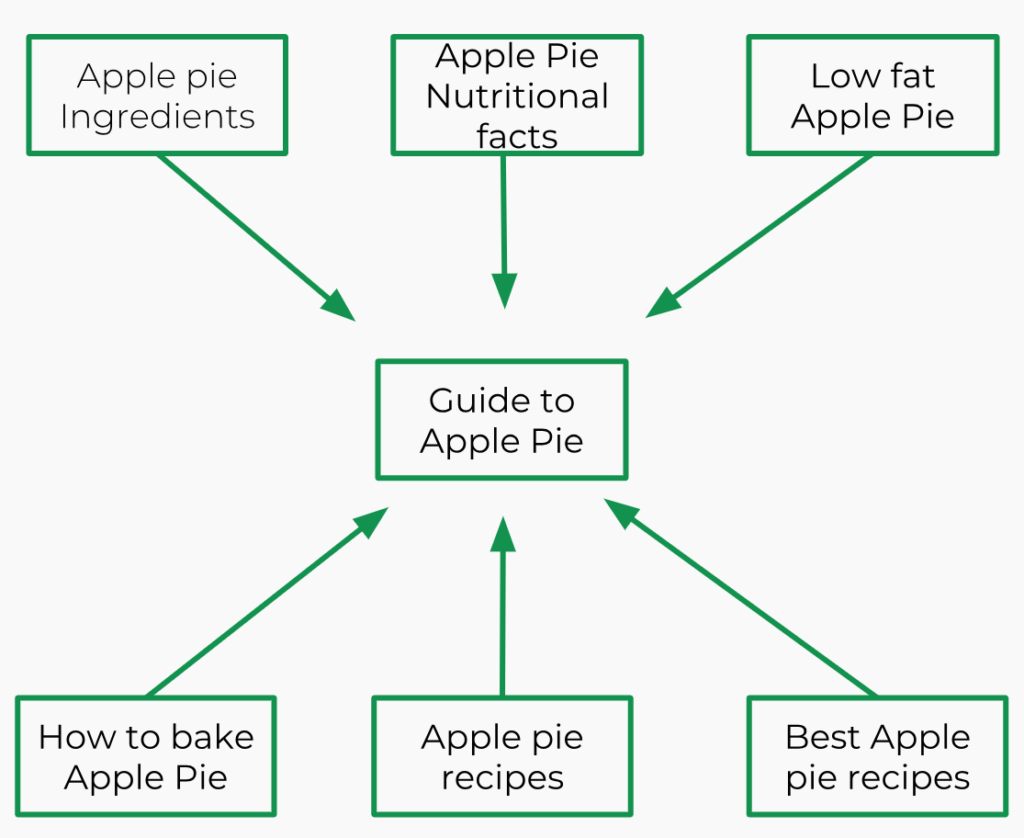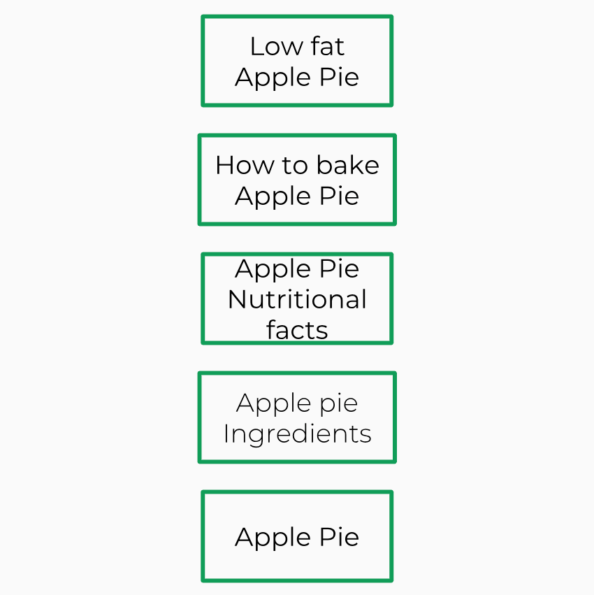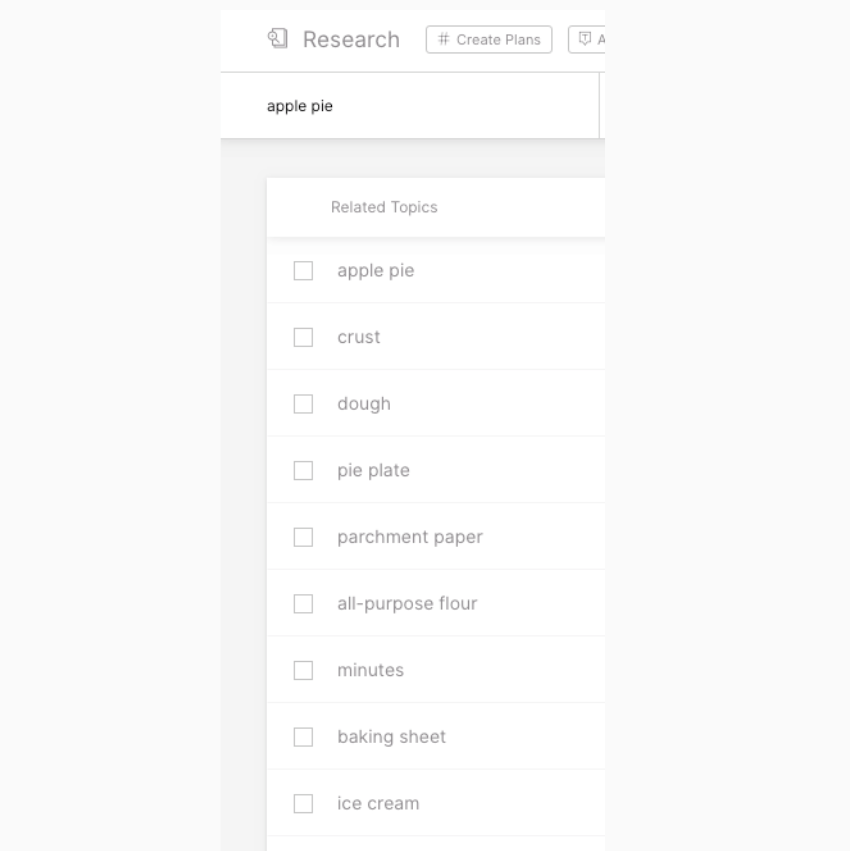How to Build A Content Plan (With Topic Cluster Examples)
Where many content plans fall short is that they don’t take into account the domains content ecosystem. This post examines an approach I use to create content plans with a strong topic cluster focus. Properly executed, this type of plan ensures every piece of content contributes to enhancing your expertise, authority, and trustworthiness in the eyes of search engines.
This article also contains topic cluster examples to help relate theory to practice. Let’s get started.

A Basic Content Plan
A typical content plan starts with a main topic accompanied by content recommendations based on:
- Keyword variants
- User intents
- Superlatives
- Questions
Take for example the topic “apple pie.” A “Guide to Apple Pie” would make an ideal piece of pillar content. That page could be supplemented by supporting material like:
- Apple pie ingredients
- Apple pie nutritional facts
- Low fat apple pie
- How to bake apple pie
- Apple pie recipes
- Best apple pie recipes

But there’s a problem with this approach.
Although it addresses a number of long-tail keywords, the plan fails to account for important related topics. Specifically, I mean those that help align the plan with the domain’s content ecosystem.
The solution is to build a content plan that accounts for the entire cluster including its related topics. So, for our apple pie content plan, we need to expand this to include associated concepts including pie crust, pie plate, pie dough, and ice cream.

Here’s one way to do it.
Step 1: Create a Standard Content Plan for the Chosen Topic
While you will expand on the subject with other topics, this first step helps build initial authority. In our example, we’ll need engaging content to address:
- Low fat apple pie
- How to bake apple pie
- Apple pie nutritional facts
- Apple pie ingredients
- Apple pie

Step 2: Build a Model of the Topic Space
Building a topic model identifies all the topics semantically related to your core subject. That also provides guidance as to where you should explore and expand the content recommendations. Aim for around five to ten topics to ensure you have enough to create a robust plan.
In the example below, I type my topic into the Research Application in MarketMuse Suite to quickly come up with my candidates.

When constructing a topic model, be careful not to confuse keywords with topics. They are fundamentally different, and failure to appreciate the difference will affect the outcome of your plan.
Let’s take a look at an example to see the difference. On the left is part of a topic model generated by MarketMuse Suite. On the right is a list of keywords generated by a free app that claims to use latent semantic indexing.

Look at the topic model in MarketMuse Suite (the image on the left). It’s apparent a semantic relationship exists between those topics. You don’t need to be an apple expert to appreciate it!
Now take a look at the list of keywords generated by that free app (the image on the right). Notice something?
It’s really a list of keywords containing the phrase “apple pie.” Those are more like variants of the single topic “apple pie” and not a comprehensive topic model.
Using this as your topic model would have a profound difference in your content plan and its result.
Step 3: Select Topics and Modify as Required to Remove Intent Fracture
All search queries exhibit intent. This step makes sure that we don’t create content that’s mismatched to that intent. We do this by verifying that each topic in our plan is associated with a clear intent.
Pay attention to instances of topic disambiguation. That’s where ambiguities in language lead to a query giving results for more than one instance.
The word “apple” is a perfect example. That word by itself is ambiguous. It could refer to the consumer electronics company, or it could be the fruit.
Watch out for topics exhibiting intent fracture. This occurs when there can be multiple reasons that someone is searching for that topic. Often this happens with general terms that have high monthly searches.
For example, there are many reasons someone might enter the search term “desserts.” They may be interested in:
- Recipes
- Its meaning
- Ideas for desserts
- Places that serve dessert close by

Pick topics that are core to the subject and can be expanded with other content. Use your core topic to modify any topics as needed to help zero-in on the desired intent. Continuing with our example, “crust” transforms to “apple pie crust.” In the same manner “dough” changes to “apple pie dough” while “pie plate” turns into “apple pie plate.”

Step 4: Start Building the Plan for Each Core Topic
Now it’s time to put together a plan that accounts for existing content along with the new articles.
First, examine your inventory to identify any existing pages that need to be optimized for the appropriate topic. This is a good time to check for any ranking keyword/page intent mismatches. Make a note of any missing intents as those are excellent opportunities to create new blog posts.

Step 5: Identify Expansion Signals and Build Plans for Each One
This is where the real fun begins. In this stage, we take a basic plan and flesh it out into something much more complete.
Be on the lookout for power pages. Those are the ones that have substantial authority and rank well for a large number of related terms. Pay attention to pages that rank for head terms. Those are often excellent optimization candidates. Pockets of content on one subject, lacking pillar or supporting material, is another situation of which to be aware.
Step 6: Verify Optimization Candidates
The purpose of this step is to avoid taking a high-quality page (already ranking for a well-matched term) and optimizing it for something that’s less appropriate.
There are two things we want to accomplish. First, we want to ensure every page destined for optimization aligns with the best keyword choice possible (and vice versa). Second, we want to check the content scores of these pages to make sure we aren’t spending time optimizing blog posts that are already of high quality.
At MarketMuse we have something called content score to help us objectively determine quality.
Content score is a proprietary measure of content comprehensiveness. MarketMuse technology aims to identify an ideal set of concepts (terms) for a given topic, that when incorporated using MarketMuse recommendations, would render the blog post competitive.
The content score is built using a standard scoring methodology pulling from the inclusion of this set of concepts. By evaluating the content score of a page over time, marketers can analyze the effectiveness of content changes and how the changing SERP environment impacts content comprehensiveness.
Step 7: Prioritize Content Creation and Optimization
Last but not least, prioritize the list of content opportunities. For a strategy encompassing more than a handful of pages, you’ll want to prioritize the order in which content is created or optimized.
At MarketMuse we use a proprietary metric called Opportunity Score. This composite metric measures the urgency and likelihood of success for new and optimized blog posts.
Opportunity Score takes hundreds of factors into account, including:
- Content Quality
- Content Comprehensiveness
- Search Volume
- Topical Authority
- Site Authority
- Competition
- Variants
- Relevance
- Current Coverage
Final Thoughts
This approach to content strategy admittedly takes more effort than what most content marketers undertake. However, in this environment, plans solely based on keyword volume and link metrics have little long-term potential.
Building an authoritative website isn’t about writing lots of long-form content. It’s more like putting together a puzzle. Every piece needs to fit. Your content strategy needs to account for this reality and ensure that every article is relevant and contributes to the goal.
What you should do now
When you’re ready… here are 3 ways we can help you publish better content, faster:
- Book time with MarketMuse Schedule a live demo with one of our strategists to see how MarketMuse can help your team reach their content goals.
- If you’d like to learn how to create better content faster, visit our blog. It’s full of resources to help scale content.
- If you know another marketer who’d enjoy reading this page, share it with them via email, LinkedIn, Twitter, or Facebook.
A Senior Content Strategist at MarketMuse, David has a passion for business and anything that lets me work with a team to find creative solutions to a problem. An entrepreneur at heart and a marketer by trade, his experience ranges from executing and managing complex content marketing strategies to designing go-to market strategies and product launches. Follow him on LinkedIn.